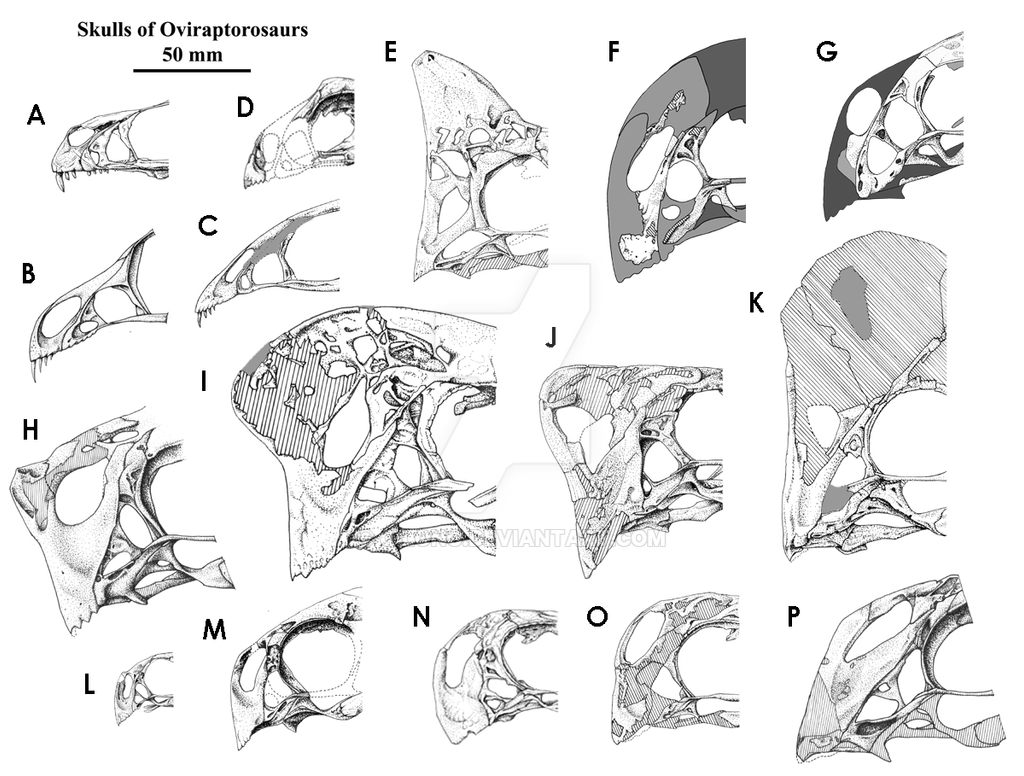There has been much debate and speculation on the diets of Mesozoic maniraptors, in part due to their diverse skull morphology that frequently deviates from what is expected of "typical" theropods. In recent years, it has been popular to argue on morphological and biomechanical grounds that herbivory and omnivory were widespread in Mesozoic maniraptors.
 |
| A digital reconstruction of the skull of the therizinosaur Erlikosaurus in multiple views, from Lautenschlager et al., 2014. |
 |
| A selection of oviraptorosaur snouts, drawn by Jaime Headden, licensed. |
 |
| A selection of enantiornithine skulls, from O'Connor and Chiappe, 2011. |
However, the existence of fruit-eating alligators and meat-eating ruminants demonstrate that morphological inference of animal diets is unreliable at best. Direct observations are what count. For my senior thesis, I looked at direct evidence of maniraptor diets (gut contents and feeding traces) throughout the Mesozoic. The results can be seen in the graph below.
The trend is clear: for most of the Mesozoic, most maniraptors were eating absolutely nothing! This is at great odds to the popular interpretation of widespread herbivory in these dinosaurs, but it makes a good amount of sense. After all, if these animals were not eating anything, their skull morphology would not be at all constrained by diet and would be free to take on other functions such as sexual display and species recognition. This revelation brilliantly explains the diversity of skull shapes in maniraptors.
Another finding of interest is the spike in hypercarnivorous maniraptor species during the Campanian. The most parsimonious explanation for this observation is that, considering the evolution of all organisms is driven by the aesthetic preferences of a single Holocene primate species (66 million years away from the last non-neornithine maniraptors), this was an attempt by the maniraptors to become more awesome, because feeding on fish or plants is lame. (And fish is not meat, what are you talking about?) Unfortunately for maniraptors, all carnivorous species died out prior to the Maastrichtian, likely because that ecospace was already dominated by other types of theropods.
What of the increase in rock-eating species during the Aptian? The great abundance of fossil species and specimens found dating to the Aptian is reflective of an increase in the generation of sedimentary rock during this time period. Evidently, a number of maniraptor species became adapted to take advantage of this resource.
References
Awesomebro, I. 2013. Y animulz musth b kewl enuff 4 me. Annals of Awesomebro 95: 26-910. doi: x8615/asum.2399
Blank, D.A. 2003. On the carnivorism and feces eating of Gazella dorcas Linnaeus, 1758 and other ungulates. Mammalia 674: 579-585.
Lautenschlager, S. 2013. Cranial myology and bite force performance of Erlikosaurus andrewsi: a novel approach for digital muscle reconstructions. Journal of Anatomy 222: 260-272. doi: 10.1111/joa.12000
Lautenschlager, S., L.M. Witmer, A. Perle, L.E. Zanno, and E.J. Rayfield. 2014. Cranial anatomy of Erlikosaurus andrewsi (Dinosauria, Therizinosauria): new insights based on digital reconstruction. Journal of Vertebrate Paleontology 34: 1263-1291. doi: 10.1080/02724634.2014.874529
O'Connor, J.K. and L.M. Chiappe. 2011. A revision of enantiornithine (Aves: Ornithothoraces) skull morphology. Journal of Systematic Palaeontology 9: 135-157. doi: 10.1080/14772019.2010.526639
Platt, S.G., R.M. Elsey, H. Liu, T.R. Rainwater, J.C. Nifong, A.E. Rosenblatt, M.R. Heithaus, and F.J. Mazzotti. 2013. Frugivory and seed dispersal by crocodilians: an overlooked form of saurochory? Journal of Zoology 291: 87-99. doi: 10.1111/jzo.12052
Zanno, L.E. and P.J. Makovicky. 2011. Herbivorous ecomorphology and specialization patterns in theropod dinosaur evolution. Proceedings of the National Academy of Sciences, USA 108: 232-237. doi: 10.1073/pnas.1011924108









No comments:
Post a Comment